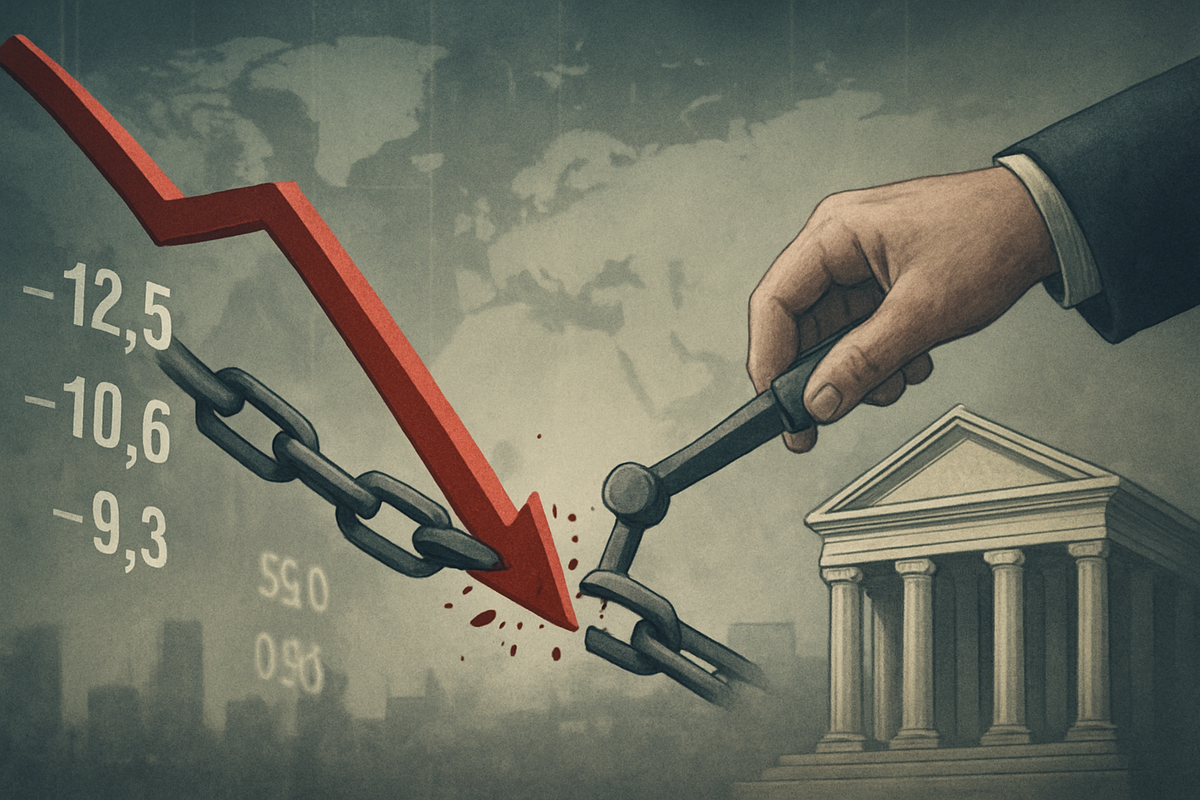
October 16, 2025 – The U.S. 10-Year Treasury Yield today tumbled below the critical 4% threshold, reaching as low as 3.97%, a significant move that sent ripples through global financial markets. This sharp decline, marking its lowest point in months, is a stark indicator of escalating economic jitters and strongly signals an impending acceleration of dovish monetary policy by the Federal Reserve.
The breach of the 4% mark reflects a pronounced "flight to safety" as investors, increasingly wary of the economic outlook, flock to the perceived stability of U.S. government bonds. This shift directly impacts borrowing costs across the economy, potentially leading to cheaper mortgages, corporate loans, and consumer credit, which could offer a much-needed stimulus to a slowing economy. However, the underlying cause—deep-seated concerns about a potential economic slowdown or recession—casts a long shadow over any immediate benefits.
The Yield's Steep Descent: A Market in Distress
Today's plunge in the 10-Year Treasury Yield below 4% was a watershed moment, underscoring the market's growing apprehension. The yield, which serves as a benchmark for a vast array of lending rates, had been under pressure for weeks, but the decisive break today solidified fears of a weakening economic landscape. This movement was not an isolated event but rather the culmination of several unsettling economic indicators and geopolitical tensions.
Leading up to this moment, a confluence of factors contributed to the downward trajectory of yields. Recent data, including a dismal Philadelphia Fed Manufacturing Index and signs of a weakening labor market with declining new job additions and subdued demand, have painted a picture of economic fragility. Furthermore, escalating U.S.-China trade tensions, threats to Federal Reserve independence, and a prolonged U.S. government shutdown have all fueled investor uncertainty, driving a sustained demand for safe-haven assets. Key players in this scenario include the U.S. Treasury Department, which issues these bonds, and the Federal Reserve, whose monetary policy directly influences market expectations. Initial market reactions were swift: equities experienced increased volatility, while safe-haven assets like gold saw a surge in demand.
The Federal Reserve, led by Chair Jerome Powell, has been closely watched. Market participants are now almost fully pricing in multiple interest rate cuts by the Fed. Following recent communications, expectations have solidified for at least two more 25-basis-point interest rate cuts by the end of 2025 (in October and December), building on an initial rate-cutting cycle that reportedly began in September. This aggressive repricing of future rate cuts reflects the market's conviction that the Fed will be compelled to act decisively to support economic growth and prevent a deeper downturn.
Companies Navigating a Shifting Landscape
The significant drop in the 10-Year Treasury Yield below 4% will create distinct winners and losers across various sectors of the economy, forcing companies to adapt their strategies to a new, lower-rate environment.
Potential Winners:
- Real Estate and Homebuilders: Companies like D.R. Horton (NYSE: DHI) and Lennar Corporation (NYSE: LEN) stand to benefit significantly from lower mortgage rates. Reduced borrowing costs for homebuyers could stimulate demand, making homeownership more affordable and potentially boosting new home sales and construction activity.
- High-Growth Technology Companies: Tech giants such as Apple (NASDAQ: AAPL) and Microsoft (NYSE: MSFT), which often rely on future earnings growth, typically see their valuations improve in a lower interest rate environment. The present value of their projected future cash flows increases when the discount rate (influenced by Treasury yields) falls, making their stocks more attractive to investors.
- Utilities and Dividend Stocks: Companies in the utility sector, like NextEra Energy (NYSE: NEE), and other high-dividend-paying stocks often become more appealing when bond yields fall. Their relatively stable income streams offer a more attractive alternative to the lower returns on fixed-income investments.
- Companies with High Debt Loads: Businesses that carry substantial debt, especially those with variable-rate loans, could see their interest expenses decrease, improving their profitability. This might include certain industrial or retail companies that have taken on leverage for expansion.
Potential Losers:
- Banks and Financial Institutions: Large banks such as JPMorgan Chase & Co. (NYSE: JPM) and Bank of America Corporation (NYSE: BAC) could face pressure on their net interest margins (NIM). Lower long-term yields, particularly if short-term rates remain relatively higher or fall at a slower pace, can compress the profit banks make from lending. Their profitability often relies on the spread between what they pay for deposits and what they earn from loans.
- Insurance Companies: Insurers, including MetLife, Inc. (NYSE: MET), typically invest heavily in long-term bonds to match their liabilities. Falling yields mean lower returns on these investments, which can impact their profitability and ability to meet future obligations.
- Pension Funds and Savers: Pension funds, which rely on investment returns to meet future payouts, will find it more challenging to achieve their target returns in a low-yield environment. Similarly, individual savers who depend on interest income from savings accounts or certificates of deposit will see their returns diminish.
Companies across the board will need to reassess their capital allocation strategies, debt management, and investment plans in light of this new interest rate landscape. Those with strong balance sheets and adaptable business models will be better positioned to navigate the challenges and capitalize on emerging opportunities.
Wider Significance: A Bellwether for Economic Health
The plummeting U.S. 10-Year Treasury Yield below 4% is far more than just a technical market movement; it serves as a powerful bellwether for the broader economic health and market sentiment. This event fits into a pattern of increasing global economic uncertainty, where investors are grappling with persistent inflation, geopolitical instability, and the lingering after-effects of aggressive monetary tightening cycles. The decisive move today suggests that the market believes the Federal Reserve's previous rate hikes may have overshot, leading to an impending slowdown that necessitates a rapid reversal of policy.
The ripple effects of this yield decline are extensive. Competitors and partners across various industries will feel the impact. For instance, lower borrowing costs could intensify competition in sectors like technology and real estate, enabling more aggressive expansion or M&A activities for well-capitalized firms. Conversely, financial institutions dependent on healthy net interest margins could face increased pressure, potentially leading to consolidation or a renewed focus on fee-based income. Regulatory bodies, particularly the Federal Reserve, will be under intense scrutiny. The market is effectively demanding a more accommodative stance, and the Fed's response will dictate the trajectory of monetary policy for the foreseeable future. This situation also brings to the forefront discussions about potential "yield curve control" measures, though direct intervention remains a high bar.
Historically, significant drops in the 10-Year Treasury Yield have often preceded or coincided with periods of economic slowdowns or recessions. For example, during the lead-up to the 2008 financial crisis and the dot-com bubble burst in the early 2000s, similar inversions or sharp declines in long-term yields signaled severe economic distress. While not a perfect predictor, the current movement echoes these historical precedents, reinforcing concerns that the U.S. economy might be heading for a challenging period. The market's current positioning indicates a strong belief that the Fed will prioritize economic stability over inflation containment in the near term, even if it means tolerating inflation slightly above its 2% target.
What Comes Next: Navigating the Uncertainty
The immediate aftermath of the 10-Year Treasury Yield falling below 4% is likely to be characterized by heightened market volatility as investors fully digest the implications of this significant shift. In the short term, expect continued strength in safe-haven assets, including gold and potentially the U.S. dollar, as capital flows away from riskier ventures. Equity markets, particularly growth stocks, might see some initial relief from lower discount rates, but this could be offset by broader concerns about corporate earnings in a slowing economy. Companies will likely pivot towards optimizing their balance sheets, potentially refinancing existing debt at lower rates, and re-evaluating expansion plans.
Looking further ahead, the long-term possibilities hinge critically on the Federal Reserve's response. If the Fed indeed embarks on a series of aggressive rate cuts as the market anticipates, it could provide a much-needed stimulus, potentially engineering a "soft landing" for the economy. However, there's also the risk of the Fed being "behind the curve," meaning that economic weakness could accelerate faster than policy adjustments, leading to a deeper recession. Market opportunities may emerge in sectors that benefit from lower borrowing costs, such as housing and infrastructure, or in defensive sectors that perform well during economic downturns. Challenges will persist for financial institutions and those reliant on robust economic growth. Potential scenarios range from a mild, short-lived recession followed by a recovery, to a more prolonged period of sluggish growth if the underlying economic issues are more structural.
Strategic adaptations will be crucial for businesses. Companies with strong cash flows and less reliance on debt will be better positioned to weather the storm. Those with significant international exposure may need to consider hedging strategies against currency fluctuations and global economic headwinds. Investors should brace for a period of uncertainty, focusing on diversification and high-quality assets. The coming months will be a test of the Fed's ability to navigate a complex economic landscape while balancing the dual mandates of price stability and maximum employment.
Comprehensive Wrap-Up: A Pivotal Moment for the Market
The plunge of the U.S. 10-Year Treasury Yield below 4% on October 16, 2025, is a pivotal moment that encapsulates the market's profound anxieties regarding the future trajectory of the U.S. economy. It is a clear signal that investors are bracing for a significant economic slowdown, if not an outright recession, and are now overwhelmingly anticipating an aggressive dovish pivot from the Federal Reserve. The immediate implications include lower borrowing costs across the economy, a surge in demand for safe-haven assets, and increased volatility in equity markets, with clear winners and losers emerging across various sectors.
Moving forward, the market will be meticulously watching the Federal Reserve's actions. The expectation of multiple rate cuts by the end of 2025 is firmly embedded in market pricing, and any deviation from this path could trigger significant reactions. The ability of the Fed to effectively manage these expectations while steering the economy through a period of potential contraction will be paramount. Companies will need to demonstrate agility, adapting their financial strategies and business models to thrive in a low-interest-rate, potentially low-growth environment.
The lasting impact of this event could redefine market dynamics for the coming years, emphasizing capital preservation and stable returns over aggressive growth. Investors should prioritize a disciplined approach, focusing on companies with robust balance sheets, sustainable business models, and a clear competitive advantage. Monitoring key economic indicators, particularly inflation data, employment figures, and manufacturing indices, alongside the Federal Reserve's forward guidance, will be essential in the coming months to discern the true depth and duration of this economic shift. This moment underscores the interconnectedness of global finance and the powerful influence of sovereign bond markets as a barometer for economic health.
This content is intended for informational purposes only and is not financial advice





